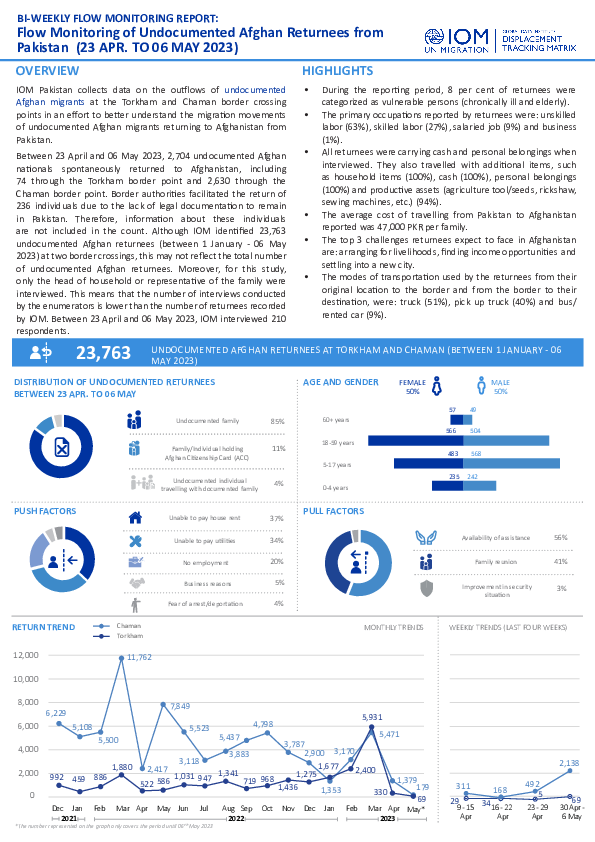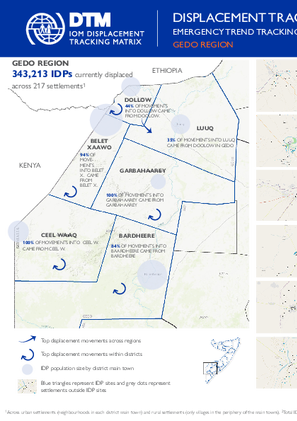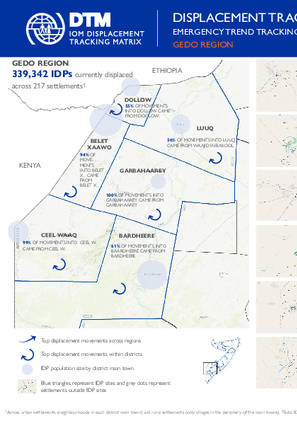-
Countries
-
Data and Analysis
-
Special Focus
-
Crisis Responses

Contact
DTM Pakistan, iomisbdtmremapteam@iom.int
Language
English
Location
Pakistan
Period Covered
Apr 23 2023
May 06 2023
Activity
- Flow Monitoring
IOM Pakistan collects data on the outflows of undocumented Afghan migrants at the Torkham and Chaman border crossing points in an effort to better understand the migration movements of undocumented Afghan migrants returning to Afghanistan from Pakistan.
Between 23 April and 06 May 2023, 2,704 undocumented Afghan nationals spontaneously returned to Afghanistan, including 74 through the Torkham border point and 2,630 through the Chaman border point. Border authorities facilitated the return of 236 individuals due to the lack of legal documentation to remain in Pakistan. Therefore, information about these individuals are not included in the count. Although IOM identified 23,763 undocumented Afghan returnees (between 1 January - 06 May 2023) at two border crossings, this may not reflect the total number of undocumented Afghan returnees. Moreover, for this study, only the head of household or representative of the family were interviewed. This means that the number of interviews conducted by the enumerators is lower than the number of returnees recorded by IOM. Between 23 April and 06 May 2023, IOM interviewed 210 respondents.

Contact
DTM Nigeria, iomnigeriadtm@iom.int
Language
English
Location
Nigeria
Period Covered
May 01 2023
May 07 2023
Activity
- Mobility Tracking
- Event Tracking
The DTM Emergency Tracking Tool (ETT) is deployed to track and to collect information on large and sudden population movements, provide frequent updates on the scale of displacement and quantify the affected population when needed. As a sub-component of the Mobility Tracking methodology in Nigeria, ETT utilises direct observations and a broad network of key informants to capture the best estimates of the affected population per location, enabling targeted humanitarian response planning.
Between 1 and 7 May 2023, a total of 1,639 new arrivals were recorded in locations in Adamawa and Borno states. The new arrivals were recorded at locations in Askira/Uba, Bama, Gwoza, Hawul, Kala Balge* and Monguno Local Government Areas (LGAs) of the most conflict-affected State of Borno and in Fufore, Gombi, Hong, Lamurde, Maiha, Michika, Mubi North, Mubi South, Song, Yola North and Yola South LGAs of Adamawa State

Contact
DTM Nigeria, iomnigeriadtm@iom.int
Language
English
Location
Nigeria
Snapshot Date
May 02 2023
Activity
- Mobility Tracking
- Event Tracking
On the 2nd of May, windstorms struck Boarding Primary School Camp (Transit Camp) in Kala/balge LGA of Borno State. The windstorms affected a total of 194 individuals from 73 households. The windstorms also damaged 20 shelters and five brick/block latrines.

Contact
DTM Nigeria, iomnigeriadtm@iom.int
Language
English
Location
Nigeria
Period Covered
May 08 2023
May 09 2023
Activity
- Mobility Tracking
- Event Tracking
Between 8 and 9 May, clashes between herders and farmers were reported in the communities of Imande Lortim and Tse Vambe in the Nzorov ward and the community of Tse-Gyer in the Mbabai ward of Guma LGA in Benue State. The clashes affected 492 individuals and displaced 332 individuals from Tse-Gyer to Uikpam IDP Camp. While the affected individuals in Imande Loritim and Tse Vambe remained in the communities. As a result of the clashes, 12 fatalities and 36 injuries were reported.

Contact
DTMUkraine@iom.int
Language
English
Location
Ukraine
Snapshot Date
Apr 30 2023
Activity
- Baseline Assessment
The Registered IDP Area Baseline Assessment provides granular data on the number and geographic location of officially registered internally displaced persons (IDPs). This report assesses registered IDP presence at the raion level, also mapping the recorded change since the previous round. Round 23 presents the data of the registered IDP population disaggregated by gender and age, as well as their distribution for three specific age groups.
The data collected for the Area Baseline Assessment Round 23 reflects the registered IDP population as of 30 April 2023 across 23 oblasts and Kyiv city. In the covered areas, the number of registered IDPs was collected for 108 raions and 984 hromadas (74% of all hromada covered in Ukrainian government-controlled areas). Data disaggregated by age and gender were provided for 75 per cent of the administrative units covered.

Contact
DTM Somalia, IOMSomaliaDTM@iom.int
Language
English
Location
Somalia
Period Covered
Apr 15 2023
Apr 19 2023
Activity
- Mobility Tracking
- Event Tracking
There are 343,213 individuals currently displaced by drought in Gedo region. Since round 58 an estimated 4,958 IDPs arrived at the assessed settlements.

Contact
DTM Somalia, IOMSomaliaDTM@iom.int
Language
English
Location
Somalia
Period Covered
Apr 08 2023
Apr 12 2023
Activity
- Mobility Tracking
- Event Tracking
There are 339,342 individuals currently displaced by drought in Gedo region. Since round 57 an estimated 3,437 IDPs arrived at the assessed settlements.

Contact
DTM Somalia, IOMSomaliaDTM@iom.int
Language
English
Location
Somalia
Period Covered
Apr 01 2023
Apr 05 2023
Activity
- Mobility Tracking
- Event Tracking
There are 340,375 individuals currently displaced by drought in Gedo region. Since round 56 an estimated 7,598 IDPs arrived at the assessed settlements.

Contact
hyakubi@iom.int
Language
English
Location
Mongolia
Period Covered
Jun 01 2022
Aug 31 2022
Activity
- Community Perception
- Mobility Tracking
- Baseline Assessment
Энэхүү судалгаа нь Улаанбаатар хотын хүн ам зүй, шилжилт хөдөлгөөн ба хэрэгцээ шаардлагыг тодорхойлоход чиглэсэн үндсэн сэдвүүдийн хүрээнд 2022 оны 6, 7, 8 дугаар сарын тойм мэдээллийг харуулсан болно. Уг судалгаа нь Монгол дахь ОУШХБ-аас Улаанбаатар хотод хийсэн хөдөлгөөнийг тандах ДТМ судалгааны аргачлалын хоёр дахь удаагийн тоон мэдээлэл нэгтгэлийн үе шат юм. Нэгдүгээр шатны тоон мэдээлэл нэгтгэлийн адил энэхүү судалгаагаар Улаанбаатар хотын хэмжээнд хүн амын бодит тоон мэдээлэл, суурь тоон үзүүлэлт, шилжин ирэгсэд ба явагсад (шилжилт хөдөлгөөн), хөдөлмөр эрхлэлт, санхүүгийн нөхцөл байдал, шилжилт хөдөлгөөнтэй холбоотой тулгамдаж буй асуудлууд, үйлчилгээний хүртээмж болон дэд бүтэц гэсэн найман үндсэн сэдвийг авч үзсэн болно. Тоон мэдээллийг Улаанбаатар хотын хамгийн жижиг засаг захиргааны нэгж болох хэсгийн1 нутаг дэвсгэрийн нөхцөл байдал, мэдээлэл нэгтгэгчийн мэдлэгийн нөөц бололцоо, мэдээллийн нээлттэй байдлаас хамааран хэсгийн ахлагч нараар тандалт судалгаа, ярилцлага хийх замаар нэгтгэсэн болно. Олон улсын шилжилт хөдөлгөөний байгууллага (ОУШХБ)-ын өмнөх судалгаануудаас харахад газрын доройтол, уур амьсгалын өөрчлөлт зэрэг хүчин зүйлс Монгол Улсын уламжлалт амьдралын хэв маягийг өөрчилж байгааг бидний хийсэн өмнөх судалгаанууд тогтоосоор байна. Ган, зудын2 давтамж нэмэгдэж, ажлын байр цөөн, амьдрах орчин нөхцөл хангалтгүй, хөдөөгийн хүн амын мал аж ахуйгаас хараат байдал зэрэг нь суурин газар болон бусад аймаг3 орон нутаг руу чиглэсэн шилжилт хөдөлгөөнийг нэмэгдүүлэх хүчин зүйл болсоор байна. Тэдгээр шилжих хөдөлгөөний үндсэн шинж чанарыг ойлгоход Монгол Улсын хэмжээндөөр өөр байршилд ажиллаж амьдарч, шилжилт хөдөлгөөнд оролцож буй хүн амын бодит тоон мэдээлэл шаардагдах бөгөөд мэдээллийн зөрүүтэй байдал үндсэн шинж чанарыг ойлгоход саад болж байна. Энэхүү судалгаа нь Улаанбаатар хотын хүн ам, шилжилт хөдөлгөөний бодит мэдээллийг олж авах замаар энэ хоёр мэдээлэл хоорондын зөрүүг арилгаж дотоодын шилжилт хөдөлгөөний талаарх бодлого, үйл ажиллагааг бодит мэдээллээр хангах, мэдээллийн баазыг нэмэгдүүлэх зорилготой.

Contact
hyakubi@iom.int
Language
English
Location
Mongolia
Period Covered
Jun 01 2022
Aug 31 2022
Activity
- Community Perception
- Mobility Tracking
- Baseline Assessment
This report provides an overview of key thematic areas covered by the Ulaanbaatar city-wide rapid assessment on population, migration and needs between June and August 2022. Current data collection is the second phase of the Displacement Tracking Matrix Mobility (DTM) tracking assessment done by IOM Mongolia in Ulaanbaatar.
Similar to phase one, this study explores eight primary themes across Ulaanbaatar, namely, population baseline figures, registration, internal arrivals and departures (migration), employment, financial situation, mobilityrelated challenges, and services and infrastructure. Data are collected through key informant interviews with kheseg leaders, who are well-informed about their communities, resources and local context.
Previous IOM studies have found that a combination of complex factors, including land degradation and climate change, are altering traditional migration patterns in Mongolia. More frequent drought and dzuds, insufficient job opportunities, inadequate living conditions, and rural population’s livestock dependency has directly increased the level of migration to urban areas and other aimags.
Understanding the nature of these migration patterns has been hindered by discrepancies between census data, registration data, and the reality of people living in and migrating between different locations across Mongolia. By obtaining data on population and internal migration in Ulaanbaatar city, this study aims to bridge the gap in up-to-date data collection and analysis to inform policies and actions on internal migration.